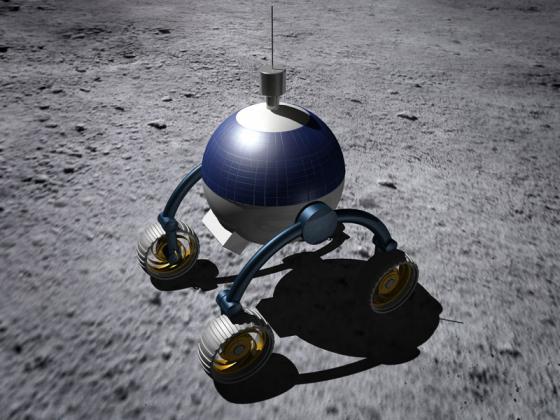Nvidia's Tegra Platform May Be Heading to the Moon
Nvidia's Tegra platform is being used to design two rovers that will travel across the moon next year.
Nvidia's Tegra platform may be heading to the moon next year as part of Google's Lunar X-PRIZE competition. One of the competitors, a privateer team named Team Synergy Moon, plans to use several Tegra systems to create a couple of rovers capable of crawling across the lunar landscape.
So what is Google's Lunar X PRIZE? It's a $30 million competition for the first privately funded team to send a robot to the moon.
"A total of $30 million in prizes are available to the first privately funded teams to safely land a robot on the surface of the Moon, have that robot travel 500 meters over the lunar surface, and send video, images and data back to the Earth," the Lunar X PRIZE site explains. "Teams must be at least 90-percent privately funded, though commercially reasonable sales to government customers are allowed without limit."
To develop their robots, Team Synergy Moon collaborated with Martin Peniak, a young scientist known for his work on the Mars Rover Simulator developed in conjunction with the European Space Agency (ESA). Peniak reportedly chose to take the Tegra route after reading an article about a neural network using Nvidia GPU acceleration. After that, Peniak chose CUDA as a basis for the rovers' development and underlying AI.
As seen on Team Synergy Moon's website, the Tesla Prospector will be the one that fulfills the competition's 500 meter requirement while taking samples and sending images and data back to earth. The team's other robot, the Tesla Surveyor, will be a bit more observant, packing twin HD cameras while rolling across the lunar surface like a silver marble -- a lunar tour guide of sorts.
"Both rovers feature an internet based control system that will allow tourists, scientist and prospectors to take control of the rovers for a virtual excursion on the moon," the team reports. "Both the Telsa Prospector and Surveyor will be capable of autonomous operations, able to take care of themselves and carry out exploration missions on their own, saving their observations for later transmission to earth or streaming near real time video of their adventures. The Tesla Prospector will also carry a set of microbots, that will carry out specialized scientific and artistic projects."
If Team Synergy Moon wins the competition, the rocket sending a manned orbiter -- along with a moon lander containing the two rovers -- will launch in December of 2012.
Get Tom's Hardware's best news and in-depth reviews, straight to your inbox.

Kevin Parrish has over a decade of experience as a writer, editor, and product tester. His work focused on computer hardware, networking equipment, smartphones, tablets, gaming consoles, and other internet-connected devices. His work has appeared in Tom's Hardware, Tom's Guide, Maximum PC, Digital Trends, Android Authority, How-To Geek, Lifewire, and others.
-
BruceOTB And what tangible benefit, if any, will this bring to mankind? we already know that the moon is just like a giant rock orbiting the earth, there's no water, no atmosphere and it can't support life. I don't see any relevant 'discoveries' on the moon now, unless some aliens occupy the moon and change it. It brightens up our night, and maybe shield us from some asteroids, that's what it is and we already know that since the 80'sReply
How bout researching on how we can achieve light speed, or better yet, how we can make worm holes a reality? -
jamie_1318 I don't think you can use Tesla in space. That CPU is way too sensitive to cosmic rays, like any other CPU designed to work in space. They use custom designed CPUs in anything that goes to space in order to avoid being totally fried by space-radiation. If anyone has any more information on the topic I'd be interested to hear.Reply -
songemu I have a sneaking suspicion that Tegra hardware is not radiation-hardened... unless this rover is going to be made of lead and clay, he's in for a world of hurt. Processors in satellite applications operate at a couple hundred megahertz at best because of radiation.Reply -
jabliese The usual cheap solution is to have 3 or more CPU's working on the same problem. If a majority come up with the same answer, go with it. If you want to be a real stickler, make sure all CPU's agree before using the answer. In case of disagreement, recalculate. And, yea, it will probably be underclocked.Reply -
cookoy the rovers will go to the moon; the tegra platform used to design the rovers will stay on earth. the rovers will have internet based control system. is the internet available now on the moon?Reply -
iceman1992 jamie_1318I don't think you can use Tesla in space. That CPU is way too sensitive to cosmic rays, like any other CPU designed to work in space. They use custom designed CPUs in anything that goes to space in order to avoid being totally fried by space-radiation. If anyone has any more information on the topic I'd be interested to hear.I believe they're using Tegra :)Reply
-
dark_knight33 BruceOTBWhat if we just quarry the moon?Reply
Ever seen "The Time Machine" (2002)? Not to mention the moon is mostly iron, so far as we know, and there is no shortage of iron on Earth, nor is it economically feasible to transport any material from the moon for commercial sale.
